Have you ever wondered how a smartphone can be produced with hundreds of tiny components so quickly and accurately? The answer lies in artificial intelligence(AI). In modern manufacturing plants, AI is playing an increasingly important role in optimizing processes, enhancing product quality, and reducing costs.
Let's explore with Sota Solutions the exciting applications of AI in the manufacturing industry and find out how this technology is reshaping the future of the sector.
1. What is artificial intelligence (AI)?
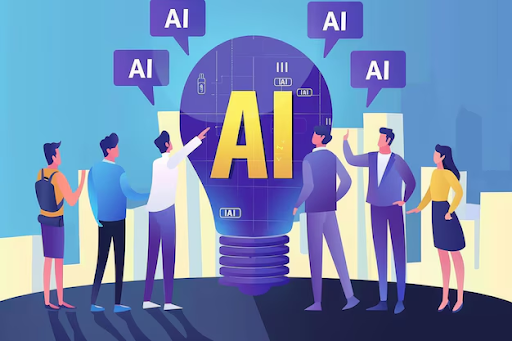
Artificial Intelligence (AI), short for the English term "Artificial Intelligence," is a field of computer science focused on creating computer systems capable of performing tasks that typically require human intelligence. In simple terms, AI is the creation of machines that can "think" and "learn" like humans.
2. Types of artificial intelligence (AI)
There are many ways to classify AI, but the two main types often mentioned are:
- Narrow AI: This type of AI is designed to perform a specific task, such as image recognition, language translation, or playing Go. Most AI applications today fall into this category.
- General AI: This is the ideal type of AI that has the ability to understand, learn, and perform any intellectual task that a human can do. However, this type of AI is still a research goal.
3. Artificial intelligence application in Vietnam
Currently, Vietnam is taking its first steps in applying AI to the agricultural and industrial sectors. Specifically, Vietnam has implemented policies to encourage technology development, including AI. In addition, financial support programs, training, and the creation of a startup environment have facilitated the application of AI.
However, to fully harness the potential of this technology, close coordination between the government, businesses, and research organizations is necessary. By investing in workforce training, developing technological infrastructure, and creating a favorable business environment, Vietnam can become a smart manufacturing hub in the region.
Potential fields for artificial intelligence (AI) applications in Vietnam:
- Manufacturing: Automating production lines, quality control of products, demand forecasting.
- Agriculture: Automating irrigation, image analysis to detect pests, weather forecasting.
- Textile: Automating the fabric cutting, sewing, and product quality inspection processes.
- Logistics: Warehouse management, optimizing transportation routes, demand forecasting.
4. Application of (AI) in manufacturing
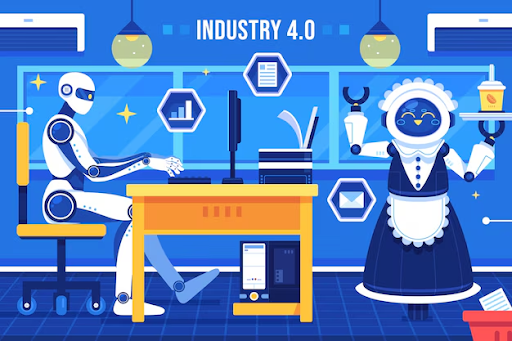
Artificial intelligence (AI) is gradually becoming an indispensable tool in the manufacturing industry, bringing significant breakthroughs in efficiency, quality, and competitiveness. Here are some important applications of AI in manufacturing:
Process automation
AI is revolutionizing the manufacturing industry through two main forms: industrial robots and automated systems. With industrial robots, AI helps perform repetitive tasks with high precision, replacing humans in dangerous and hazardous jobs, thereby increasing productivity and minimizing errors in the production process.
Additionally, with automated systems, AI helps control the production process, from raw materials to the final product. For example, in the electronics manufacturing industry, AI is used to control robots assembling electronic components, optimize the production process, and minimize errors.
Quality control
AI uses deep learning algorithms (computer vision and machine learning) to analyze product images, detecting defects, size errors, and color discrepancies from the early stages. From there, it ensures consistent and accurate product quality. For example, in the electronics industry: AI is used to inspect printed circuits, chips, and other electronic components.
Forecasting and maintenance
Based on historical data and market trends, AI can analyze sales data, inventory, and market trends to accurately predict future customer demand and build precise reporting models. Based on this analysis and reporting data, AI accurately predicts when equipment maintenance is needed, helping to minimize downtime and maintenance costs.
Supply chain management
Thanks to its ability to process large amounts of data and learn from experience, AI helps manage inventory intelligently, from determining the quantity of goods to be stocked, to implementing appropriate measures such as discounts, promotions, or clearance sales, and monitoring the expiration dates of products... From there, it helps businesses generate reports, easily plan efficient transportation, manage fleets, and optimize warehouses and delivery times.
Developing new products
AI can create many different design variations based on certain requirements and constraints, helping designers identify trends and develop suitable products. Moreover, it also has the ability to simulate the production process and the operation of the product, helping to minimize risks and save costs. For example, AI can help car designers create thousands of different design models, then select those with high aesthetic value and that meet technical standards.
Occupational safety
AI uses machine learning algorithms to analyze data collected from sensors and IoT devices. The sensors are installed throughout the factory to collect data on temperature, humidity, pollution levels, noise, and other factors that may affect workplace safety. When any abnormal signs are detected, the system will immediately send an alert to the manager or automatically activate corrective measures. AI-integrated surveillance cameras can identify dangerous behaviors such as not wearing helmets, working in hazardous areas, or using machinery improperly.
In addition, with industrial robots, drones, and automated systems, AI can help replace humans in dangerous jobs or inspect hard-to-reach areas, such as chemical storage tanks or high structures, reducing risks for workers.
5. The benefits of applying artificial intelligence (AI) in manufacturing
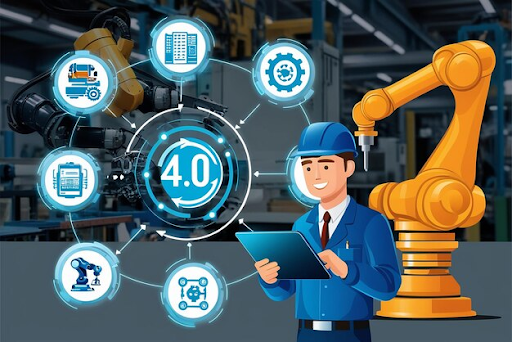
Improving product quality
AI helps detect product defects early, ensuring consistent product quality and making the production process smoother. When the production process runs smoothly, businesses can easily carry out the next steps to deliver products to customers as quickly as possible.
Reduce production costs
With applications that automate repetitive processes, optimize production schedules, and enable predictive maintenance, AI helps improve resource utilization in terms of personnel, energy, and raw materials, reduces production time, while still achieving productivity efficiency.
Innovation and enhancing competitiveness
AI has the ability to create and simulate new products according to market trends, especially with higher quality and greater diversity. From there, it helps businesses create innovations in their operations, enhancing their competitive edge against industry rivals.
Ensure safety and security standards
With the ability to analyze data from sensors and cameras to detect unsafe working conditions such as chemical leaks, electrical overloads, or dangerous behaviors of workers, AI can predict potential incidents and provide early warnings.
Additionally, AI can detect unusual activities in the network system, helping to prevent cyber attacks. When detecting abnormal signs, AI will encrypt and protect critical production data, preventing information leakage from the enterprise.
6. The challenges for businesses when applying AI in production?
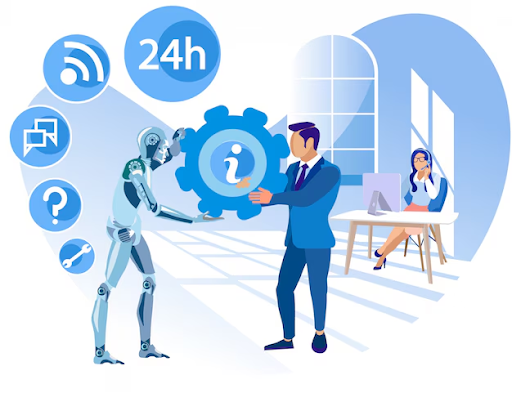
The application of AI in production brings many benefits but also comes with significant challenges. Here are some of the main challenges that businesses often encounter:
High investment and maintenance costs
Cost is a major concern for businesses when applying AI in production. When deciding to use AI in the production process, the company will incur a relatively large investment in purchasing servers, storage devices, sensors, and IoT devices to collect data, as well as specialized software for building and deploying AI models, and cloud platforms for processing big data.
Additionally, to use it, an extra investment is needed to hire AI experts to design, implement, and maintain the system. Businesses need to carefully weigh the costs and benefits before deciding to invest in AI. Building a long-term investment strategy and collaborating with technology partners can help mitigate risks and optimize costs.
Lack of quality human resources
The application of AI in production requires high-quality human resources with in-depth knowledge in both the field of production and AI technology. However, in reality, many businesses are currently facing a shortage of this type of workforce. Employees working with AI need to have a deep understanding of production processes as well as knowledge of machine learning algorithms, deep learning, and big data processing. Finding or training personnel with all these skills requires a lot of costs and sometimes takes time.
To address this issue, businesses need a long-term human resources strategy, invest in training and developing human resources, and create an attractive work environment to attract talent.
Security risks and technical incidents
Although the application of AI in production brings many benefits, it also poses security risks and technical incidents. One of the biggest risks is that the AI system can be hacked, leading to unauthorized access, theft of important production data, or even remote control of the system. This could cause production disruptions, leak important trade information, and result in financial losses.
In addition, technical failures are also a significant risk. AI algorithms can make incorrect decisions, especially in complex situations or when the input data is incomplete. For example, an AI-based quality control system might overlook defective products, leading to the production of substandard items and affecting the company's reputation. Additionally, hardware or software malfunctions can also disrupt the production process.
Incomplete legal regulations
The application of AI in production is opening up tremendous potential; however, the incomplete legal framework is one of the biggest challenges that businesses face.
Lack of specific regulations on legal liability: When AI makes a wrong decision, it is a perplexing issue. For example, if an automated robot causes an accident during the production process, who will be held responsible: the robot manufacturer, the programmer, or the business using the robot? This question does not yet have a clear answer in many legal systems.
Difficulties in protecting intellectual property rights for AI algorithms and training data: Who owns an AI algorithm developed based on a large amount of data collected from various sources?
Difficulty in protecting privacy and data security: As AI collects and processes a large amount of personal data from workers and customers, ensuring that this data is securely protected and not misused is very important.
Difficulties in regulating the relationship between humans and machines in the production process: As AI becomes increasingly intelligent and automates many tasks, how can we ensure that workers' rights are protected and that they can adapt to these changes?
Currently, in some countries and companies, there have been efforts to enact regulations on the use of AI, with major tech companies like Google and Tesla actively participating in the process of establishing AI standards and regulations.
7. The trend of AI development in manufacturing
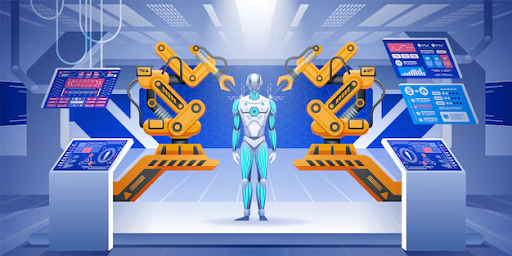
In the future, AI will become a core foundation for all manufacturing activities. Specifically:
Smart factories: Factories will be equipped with sensors, automated machinery, and AI systems to optimize every stage of the production process, from product design to delivery.
- Personalized production: AI will enable businesses to manufacture products customized to the needs of each customer at a reasonable cost.
- Smart supply chain: AI will help optimize the supply chain, from demand forecasting to inventory management and delivery.
- Collaborative robots: Robots will work alongside humans to perform complex tasks that require flexibility and creativity.
- Smart materials: AI will be used to develop new materials with self-repairing and self-adapting capabilities to the environment.
- Print 3D: AI will help optimize the 3D printing process, allowing for the production of complex products at a low cost.
Additionally, AI will further develop in the new forms of decentralized AI and edge AI. With decentralized AI, AI models will be distributed across various devices and locations, enhancing security and minimizing risks. On the other hand, with edge AI, AI will be deployed directly on devices at the field, helping to reduce latency and enhance real-time responsiveness.
8. Conclusion
Artificial intelligence is revolutionizing the manufacturing industry, transforming traditional factories into smart, efficient ecosystems. With the ability to self-learn, self-adapt, and process large amounts of data, AI not only optimizes production processes but also creates new, high-quality, and personalized products. However, to fully harness the potential of AI, businesses need to invest in technology, train their workforce, and build a solid digital foundation. At the same time, establishing a clear and transparent legal framework is also necessary to ensure that AI is developed and applied safely and responsibly.